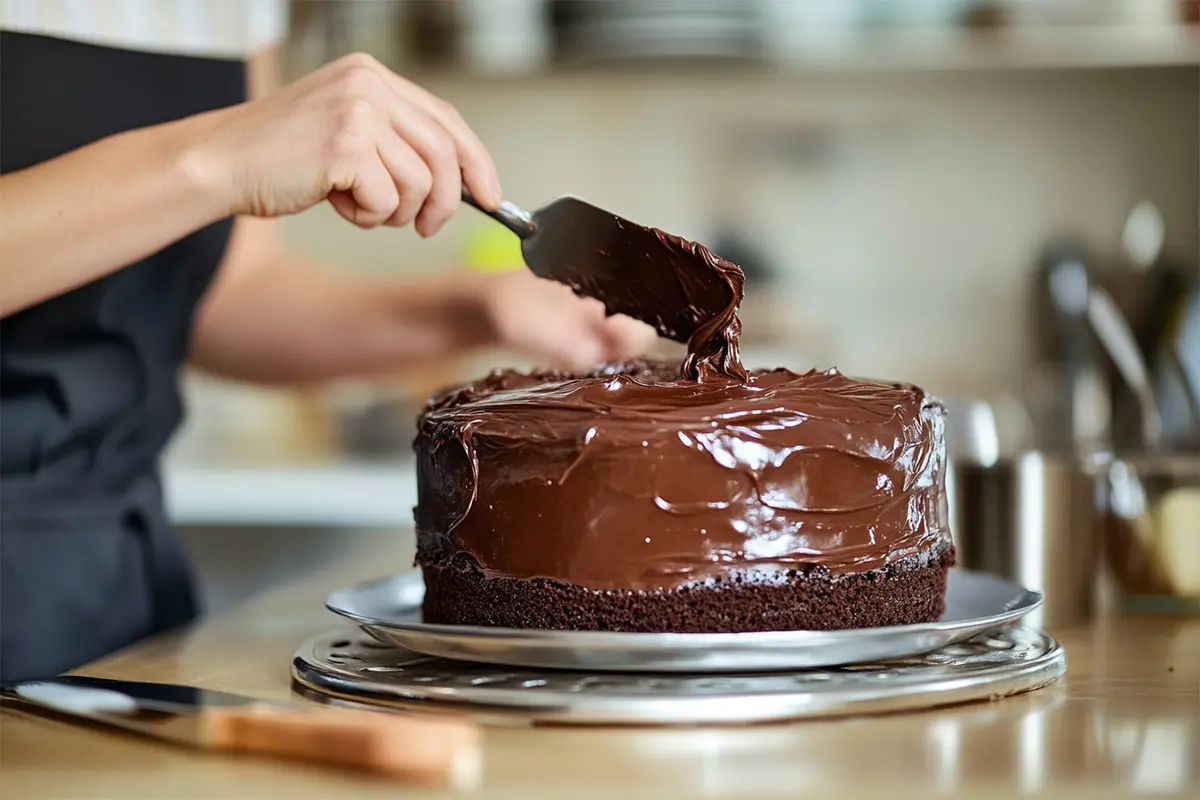Chocolate ganache is a versatile and beloved element in the world of baking. Whether you’re aiming for a smooth, glossy finish or a rich, decadent frosting, ganache can do it all. But a common question among home bakers and professionals alike is: Can you put ganache straight on a cake? The short answer is yes, but there are some important considerations to ensure the best results. In this article, we’ll explore the techniques, best practices, and tips for applying ganache directly to your cakes.
What is Ganache?
Ganache is a luxurious combination of chocolate and cream that can be used in a variety of ways in baking and dessert making. It can serve as a glaze, a frosting, or even a filling. The versatility of ganache lies in its simplicity and the ability to adjust its texture depending on the ratio of chocolate to cream.
Learn more about the history and variations of ganache.
Understanding the Basics of Ganache
Core Ingredients: Chocolate and Cream
At its core, ganache is made from just two ingredients: chocolate and cream. The type of chocolate you use—whether dark, milk, or white—can significantly impact the flavor and texture of your ganache. Dark chocolate, for example, creates a richer, more intense ganache, while milk chocolate yields a softer, sweeter result.
- Dark Chocolate: Provides a firm texture with a deep, rich flavor.
- Milk Chocolate: Yields a softer, creamier ganache.
- White Chocolate: Produces a very soft ganache, often requiring a higher chocolate-to-cream ratio.
The cream you use should be heavy cream with a high-fat content. This fat is crucial for achieving a smooth, glossy finish that sets properly.
For a practical example of applying ganache to cakes, you might want to explore the Vanilla Cake with Chocolate Ganache recipe, where ganache is used to create a decadent finish.

How Ganache Is Applied to Cakes
Preparing the Cake for Ganache
Before applying ganache directly to your cake, it’s essential to prepare the cake layers. The cake should be thoroughly cooled, and if necessary, leveled to ensure a smooth application. The ganache itself should be at a spreadable consistency—similar to peanut butter—when applied.
Tip: If your ganache begins to harden while you’re working, you can gently reheat it in the microwave at 50% power for 10-15 seconds, stirring until smooth.
Applying Ganache Directly to Cake Layers
Yes, you can apply ganache straight onto cake layers. The key is ensuring that your ganache is the right consistency. For a smooth, polished finish, the ganache should be spread evenly across the top and sides of the cake. Using a cake turntable and an offset spatula can help you achieve a smooth, professional-looking surface.
Discover the techniques and tools used in cake decorating.
Best Practices for Applying Ganache
Cooling and Leveling the Cake
Before applying ganache, it’s important to cool the cake completely. A warm cake will cause the ganache to melt and slide off, ruining the smooth finish. If your cake has a domed top, use a serrated knife to level it off. This creates a flat surface that will make it easier to apply the ganache evenly.
Techniques for Smoothing Ganache
To achieve a smooth finish, apply the ganache in layers. Start with a thin crumb coat to seal in any loose crumbs. Let this layer set before applying a thicker layer of ganache. Use a cake scraper or icing smoother to even out the surface, working your way around the cake until it’s perfectly smooth.
Tools and Equipment
The right tools can make a significant difference in the application of ganache. Here are some essentials:
- Offset Spatula: For spreading ganache evenly.
- Cake Scraper: For smoothing the sides of the cake.
- Cake Turntable: Allows you to rotate the cake easily while applying ganache.
Factors Affecting Ganache Application
Temperature Considerations
The temperature of both the ganache and the cake is crucial. If the ganache is too warm, it will be runny and difficult to work with. If it’s too cold, it will be hard and difficult to spread. Ideally, the ganache should be at room temperature and the cake should be cool but not cold.
Type of Chocolate
The type of chocolate you use will affect the texture and setting of your ganache. Dark chocolate sets firmer than milk or white chocolate, which means you may need to adjust the chocolate-to-cream ratio depending on your desired outcome.
Additional Ingredients
While traditional ganache is made with just chocolate and cream, adding ingredients like butter or corn syrup can alter the texture. Butter can make the ganache richer and add a slight sheen, while corn syrup can keep it smooth and pliable.
Troubleshooting Ganache Application Issues
Too Soft or Runny Ganache
If your ganache is too soft or runny, it’s usually due to too much cream or not enough chocolate. You can fix this by melting additional chocolate and stirring it into the ganache. If the ganache is already on the cake and too soft, try refrigerating it to help it set.
Ganache That Won’t Set
Sometimes, ganache won’t set as expected, especially if it’s made with milk or white chocolate. In such cases, reducing the amount of cream or using a higher cocoa content chocolate can help. Refrigerating the ganache can also help it set more quickly.
Fixing Split or Grainy Ganache
If your ganache splits or becomes grainy, it’s likely due to overheating or overmixing. To fix this, gently reheat the ganache over a double boiler while whisking continuously until smooth. If the ganache remains grainy, adding a small amount of warm cream and whisking vigorously can help restore its smooth texture.
Creative Uses of Ganache Beyond Cakes
Ganache for Cupcakes
Ganache isn’t just for cakes—it’s also perfect for topping cupcakes. You can dip the tops of cupcakes directly into ganache for a smooth, shiny finish, or whip the ganache and pipe it onto cupcakes for a fluffy, rich topping.
Ganache for Tarts and Truffles
Ganache also makes an excellent filling for tarts and truffles. Its rich, creamy texture pairs beautifully with a crisp tart shell or a soft, decadent truffle center.
For a creative twist on traditional desserts, you might want to check out the Sourdough Pop Tart Recipe, where ganache can be used as a filling or topping.
Decorating with Ganache
Ganache is incredibly versatile when it comes to decorating. You can pipe it into intricate designs, use it as a drip for cakes, or even glaze entire cakes with it. The possibilities are endless, making ganache a must-have in any baker’s repertoire.

FAQs About Ganache
Can I put ganache on a warm cake?
No, it’s best to apply ganache to a cooled cake. A warm cake can cause the ganache to melt and slide off, preventing you from achieving a smooth finish.
How long should I let the ganache set before decorating?
Ganache should be allowed to set for at least 30 minutes at room temperature, or you can speed up the process by placing it in the fridge for 10-15 minutes. Once set, it will be firm enough to decorate.
Do I need to refrigerate a cake with ganache?
A ganache-covered cake can be stored at room temperature for up to two days. If you need to store it longer, refrigerate the cake, but bring it to room temperature before serving to enjoy the best texture.
Can I add flavors to ganache without affecting its consistency?
Yes, you can add flavors like vanilla extract, coffee, or liquors to ganache without affecting its ability to set. Just be careful not to add too much liquid, as this can make the ganache too runny.
How do I fix ganache if it doesn’t set properly?
If your ganache doesn’t set properly, try refrigerating it. If it’s still too soft, you can melt more chocolate and stir it into the ganache to thicken it.
Conclusion: Mastering the Art of Ganache
Ganache is a versatile, delicious, and visually stunning addition to any cake. While it requires careful handling to achieve the perfect texture, the effort is well worth it. Whether you’re using it as a frosting, filling, or glaze, understanding how to apply ganache directly to a cake will elevate your baking to the next level.
For more tips and techniques on working with ganache, check out additional resources like Ganache on Wikipedia and Cake Decorating on Wikipedia. With these tools and tips, you’ll be well on your way to creating beautifully finished cakes that are as delicious as they are stunning.

